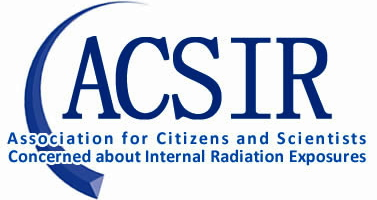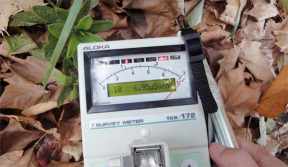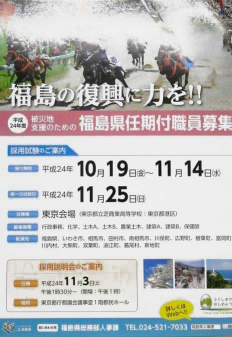The Special Rapporteur on the Right to Health from the UN Human Rights Council, Mr Anand Grover (India), will visit Japan from 15th to 26th November, 2012. This mission follows the visit to the UN in Geneva on 30th and 31st October by the Mayor of Futaba (Japan), Katsutaka Idogawa, and Toshio Yanagihara, a lawyer who represents children of Fukushima in a lawsuit demanding that the Japanese authorities evacuate them from the contaminated areas. The town of Futaba is located 3km from the Fukushima Dai-Ichi nuclear power plant and is now uninhabitable. The visit by the Special Rapporteur was requested by some governments and NGOs, including ACSIR (Japanese Association for Citizens and Scientists Concerned about Internal Radiation Exposures), which sponsored the visit by the Mayor of Futaba to Geneva. Members of ACSIR participated in the Forum organized by IndependentWHO in Geneva last May. ACSIR has just sent a particularly alarming letter about the radioactive contamination in the area to the Special Rapporteur.
♦
1. The level of contamination in which children are forced to lead normal lives
The areas where Fukushima prefectural and Japanese governments recommend Fukushima citizens to live and lead normal lives are still heavily contaminated. These areas include Fukushima city, the capital city of Fukushima prefecture, Koriyama city, and Date city. Although they are designated as “safe areas”, they are heavily contaminated. Below are some examples offered by residents in these areas, and by a radiation specialist.
1.1.
In Date city, Oguni district, at the school bus stop for Oguni Primary School, there were levels of 10μSv/h on October 18, 2012, and beside the swimming pool of the School, it was 27μSv/h. Both doses were measured by Dr. Alexey Nesterenko, the director of the Institute of Radiation Safety (BELRAD), Belarus, who recently visited Fukushima and was shocked to witness the fact that children live and go to school in such a heavily contaminated area.
These doses and his comments are reported in Shukan Kinyobi, Vol.20, No. 41, October 26, 2012. You may contact Dr. Nesterenko for further information, or we could send you the article in a pdf version. 10μSv/h represents 88 mSv/y, and 27μSv/h represents 237 mSv/y.
These levels are equivalent to those in Ukraine’s Exclusion Zone in 1991 (Ministry of Ukraine of Emergencies, 2011). According to the current law in Japan, 1mSv/y is the permissible dose for civilians. However, in the last 19 months, children have been forced to go to school where the contamination has generally been 88 mSv/y, and at times 237 mSv/y.
1.2
On 29th October 2012, Fukushima Agricultural Technology Centre in Koriyama city reported an astonishing fact: for six days they tested Japanese radishes drying under the eaves (recorded levels of 0.6μSv/h) of a concrete building. The test showed that the dried radishes which originally measured 0 Bq, later measured 3421 Bq/kg. Their conclusion was: the dose was not due to the mechanism of concentration of radiation in the process of drying; it was due to the radiation in the surrounding dust/air which the vegetable absorbed. From this result we can easily deduce that the children in the nearby school have been breathing radioactive dust. The report is available from:
http://www4.pref.fukushima.jp/nougyou-centre/kenkyuseika/kenkyu_seika_radiologic.html
The photo below shows a measurement of radiation of 6.95μSv/h in the same city, Koriyama, more precisely in a car park of Kaisei Park, taken by Dr Takemoto (see below in ‘Our Demands’) in Koriyama city, Fukushima on 5th November 2012. Children should have the right to play and to be educated in a safe place.
1.3
False radiation measurements given by the government. The vice-president of our association (ACSIR), Prof. Katsuma Yagasaki (Professor Emeritus, Ryukyu University, Condensed Matter Physics) and his team (mainly citizens of Fukushima) held a press conference on October 5, 2012, to report their findings about the difference between their measurements and the government’s data. For details, please see http://www.acsir.org/. As a result of their exhaustive measuring of over 120 monitoring sites in Fukushima prefecture, they found out that the measurements given by the government are 50-70% lower than in nearby un-decontaminated areas.
A month later on 7th November, 2012, the Ministry of Education, Culture, Sports, Science and Technology, admitted that the levels shown on their monitors were lower than the actual values. Please see their press release: http://radioactivity.mext.go.jp/ja/contents/7000/6437/24/203_1107.pdf
1.4
Fukushima Prefectural government and the Japanese government have been promoting reconstruction of Fukushima, and encouraging evacuees from Restricted Areas (more heavily contaminated areas than the above cities) to return to the heavily contaminated Restricted Areas. The administrations even encourage young people to return to these areas.
Below is a poster issued by Fukushima prefectural government (October-November 2012) recruiting staff for posts in the following villages in the Restricted Areas: Futaba town, Okuma town, Tomioka town, Namie town, etc.
If the prefectural government sends young people to these heavily contaminated areas to work and live, it would be a violation of human rights as well as a breach of the Japanese constitution, which guarantees the fundamental rights of health, safety, and happiness of the people (Article 13, Prime Minister of Japan and His Cabinet).
http://www.kantei.go.jp/foreign/constitution_and_government_of_japan/constitution_e.html
2. Contaminated Food and its distribution, particularly for children at school
Fukushima prefectural and Japanese governments have been sending contradictory messages about food and contamination. On October 8, 2012, the Prime Minister called for systematic radiological monitoring to check all rice produced in Fukushima prefecture (Fukushima Minpo Newspaper, October 8, 2012, http://www/minpo.jpnews/detail/201210084119). Only four days later, the Minister of Agriculture, Forestry and Fisheries suggested at a press conference that the radiological monitoring of all rice should be stopped and that, as long as the random monitoring of the rice from the same district showed an acceptable dose, unmonitored rice could be distributed (Ministry of Agriculture, Forestry and Fisheries, http://www.maff.go.jp/j/press-conf/min/121012.html ).
This recommendation will have a devastating effect on the children not only of Fukushima but throughout Japan, as they are all likely to eat untested rice at school. It is known from the experience of the Chernobyl accident that hotspots are scattered unevenly, and within in the same district many different levels can be found, from less contaminated spots to heavily contaminated spots. That is why the system of radiological monitoring of all rice was introduced. We feel that the health of our children must be protected at all costs.
3. Health Management Survey of Fukushima Prefectural Residents
This Inquiry, led by Profs. Shun-ichi Yamashita and Shin-ichi Suzuki at Fukushima Prefecture Medical University, has been controversial particularly because of its recommendations concerning children. Prof. Yamashita is now known worldwide for his remark: “There is no harm to the population from levels of radiation up to 100 mSv.” (OurPlanetTV, May 3, 2011 http://www.ourplanet-tv.org/?q=node/1037 ).
Earlier this year (January 16, 2012), Professors Yamashita and Suzuki sent a letter to members of the Japanese Thyroid Association (Prof. Yamashita is its president) requesting that, for the next two years, they do not examine children between 0 and 18 years old who have been examined by the survey team and diagnosed with nodules smaller than 5 mm or cysts smaller than 20 mm. This letter became public after the above mentioned Dr Takemoto of Koriyama city acquired a copy of the letter through a Request for Disclosure. An English translation of the letter is available from Fukushima Voice, http://fukushimavoice-eng.blogspot.jp/2012_05_01_archive.html
In contrast to the optimistic view of the inquiry team, there is a warning report by members of the medical professions. Please refer to Dr. Michiyuki Matsuzaki’s (ACSIR member) statement about the result of the Health Management Survey of Fukushima Prefectural Residents, http://fukushima-evacuation-e.blogspot.jp/2012_07_01_archive.html
In conclusion, the inquiry team has failed, as health professionals, to look after the interests of the residents and children of Fukushima. Their failures include: not disclosing detailed results of ultrasound examinations to the examinees; refusing further examinations for those children with nodules and cysts; and putting pressure on other medical institutions, including hospitals, not to examine Fukushima residents for symptoms linked to radiation. The residents of Fukushima have many such stories to tell about the doctors they have consulted. This is also a violation of human rights.
Our Demands
We should like you to talk to the citizens of Fukushima to verify the above facts, and to get first-hand information from them. May I suggest that you meet the following two people, for information and for our appeal to the United Nations Human Rights Council:
1. Ms. Miwa CHIWAKI: resident of Nishigo village, Fukushima; member of ACSIR and an active member of Fukushima Network for Saving Children from Radiation. Ms. CHIWAKI was invited by IndependentWHO (Geneva) to report to “The Scientific and Citizen Forum on Radiation Protection : from Chernobyl to Fukushima”, in Geneva, May 12, 2012.
2. Dr. Yasushi TAKEMOTO (doctor of medicine, specialising in oral surgery): resident of Koriyama city; advisor to a citizen group “Safety, Security, Action in Koriyama”.
Yours sincerely,
Shoji SAWADA, Professor Emeritus (physics), Nagoya University
President of ACSIR


